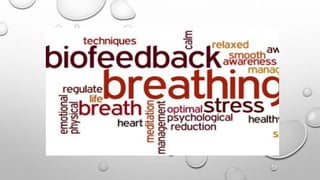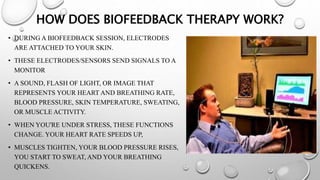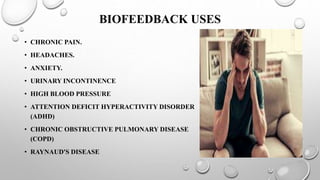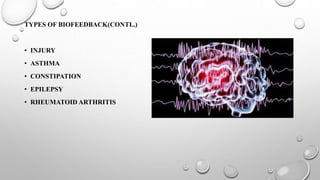Biofeed back
- 2. When you raise your hand to wave hello to a friend
- 3. lift your knee to take another step
- 5. HOW DOES BIOFEEDBACK THERAPY WORK? âĒ DURING A BIOFEEDBACK SESSION, ELECTRODES ARE ATTACHED TO YOUR SKIN. âĒ THESE ELECTRODES/SENSORS SEND SIGNALS TO A MONITOR âĒ A SOUND, FLASH OF LIGHT, OR IMAGE THAT REPRESENTS YOUR HEART AND BREATHING RATE, BLOOD PRESSURE, SKIN TEMPERATURE, SWEATING, OR MUSCLE ACTIVITY. âĒ WHEN YOU'RE UNDER STRESS, THESE FUNCTIONS CHANGE. YOUR HEART RATE SPEEDS UP, âĒ MUSCLES TIGHTEN, YOUR BLOOD PRESSURE RISES, YOU START TO SWEAT, AND YOUR BREATHING QUICKENS.
- 6. RELAXATION EXERCISES ARE USED IN BIOFEEDBACK âĒ DEEP BREATHING
- 7. GUIDED IMAGERY â CONCENTRATING ON A SPECIFIC IMAGE (SUCH AS THE COLOUR AND TEXTURE OF AN ORANGE) TO FOCUS YOUR MIND AND MAKE YOU FEEL MORE RELAXED
- 8. PROGRESSIVE MUSCLE RELAXATION -- ALTERNATELY TIGHTENING AND THEN RELAXING DIFFERENT MUSCLE GROUPS
- 9. âĒ MINDFULNESS MEDITATION -- FOCUSING YOUR THOUGHTS AND LETTING GO OF NEGATIVE EMOTIONS
- 10. TYPES OF BIOFEEDBACK âĒ ELECTROMYOGRAM (EMG). âĒ THERMAL. âĒ NEUROFEEDBACK OR ELECTROENCEPHALOGRAPHY (EEG). âĒ ELECTRODERMALACTIVITY (EDA) âĒ HEART RATE VARIABILITY (HRA).
- 11. BIOFEEDBACK USES âĒ CHRONIC PAIN. âĒ HEADACHES. âĒ ANXIETY. âĒ URINARY INCONTINENCE âĒ HIGH BLOOD PRESSURE âĒ ATTENTION DEFICIT HYPERACTIVITY DISORDER (ADHD) âĒ CHRONIC OBSTRUCTIVE PULMONARY DISEASE (COPD) âĒ RAYNAUD'S DISEASE
- 12. TYPES OF BIOFEEDBACK(CONTI..) âĒ INJURY âĒ ASTHMA âĒ CONSTIPATION âĒ EPILEPSY âĒ RHEUMATOID ARTHRITIS













